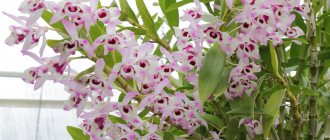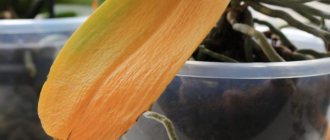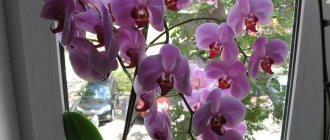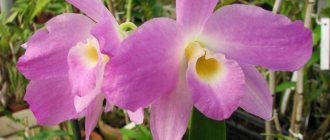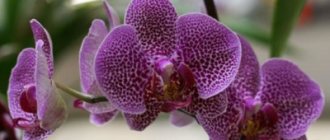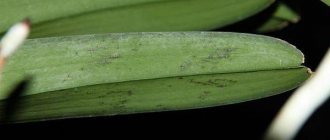Annual development cycle
To organize proper care for Dendrobium Nobile at home, it is necessary to distinguish between periods in the annual development cycle of orchids of this species.
The development cycle can be divided into 4 periods:
Growing season
In the spring-summer period (from March–April, including June), the plants wake up and vegetative development begins. At the base of the pseudobulbs, babies form, stems and leaves grow.
The impetus for the development of new shoots occurs only under certain lighting conditions.
If it is favorable throughout the year (i.e. 12 months in a row), then new shoots can appear constantly, making the plants more luxuriant.
The period of growth of new pseudobulbs and young roots
In May and until September, the development of the above-ground mass is accompanied by the active growth of old and the formation of young roots.
During the development of new shoots, it is advisable to keep the orchid sunny and warm, and after formation - sunny but cool. In such conditions, the orchid will quickly and well grow green mass and bloom faster.
As it develops, the new shoot elongates and swells, ultimately forming a new pseudobulb.
As soon as the new sprout is rounded and produces its last leaf at the top (“stop leaf”), it is considered mature, i.e. passed from the “new sprout” state to the “young pseudobulb” state.
Rest period
In September, the growth of shoots and the formation of pseudobulbs ends. Flower buds are being laid. From October there begins a dormant period, which (depending on the variety) lasts until January-February.
The most difficult thing in caring for the hybrid Dendrobium Nobile is the dormant period. Many different natural species that live in different climatic conditions take part in the formation of hybrids of this group.
In one area, the sun shines all year round and there is heavy rainfall, while in another, the year is clearly divided into a period of rain and a period of drought. Hence the different behavior of plants.
Under the conditions of an ordinary windowsill, the light intensity in winter drops so low that the metabolism inside the orchid is inhibited, and it can neither grow nor bloom.
About the same thing will happen to her as to our trees outside the window, when they shed their leaves and “fall asleep” until spring.
This condition is unnatural for an orchid. This can be avoided by installing artificial light lamps over the plants in the winter.
Flowering period
The appearance of flower buds marks the transition from dormancy to flowering. The main time for orchid flowering is in the winter from January-February to May.
To enjoy your orchid blooming longer, you need to keep it in a cool place where it is dry and away from direct sunlight.
Dendrobium propagation
When propagating Dendrobiums, several different methods are used. Let's look at them in order.
Cuttings
Let us draw your attention to the fact that this method is more applicable for the propagation of deciduous species (for example, Dendrobiums Parisha and Noble). When planning to transplant an adult plant, separate the old pseudobulbs from the mother bush. Divide these pseudobulbs into cuttings about 10 cm long so that each cutting has two to three internodes. Treat the sections with garden varnish or crushed activated carbon. Note that sections on the mother plant must also be processed. And you don’t need to water it for several days for the wounds to heal. Let's return to our cuttings. For better rooting, stick them into damp sphagnum moss, and place the entire structure in a prepared greenhouse (for example, a container with a lid or a plastic bag with a zipper). No more than two cuttings can be rooted in each greenhouse. Place the greenhouses in a bright, warm place. The rooting temperature should be maintained within 22 – 26 degrees. Direct sunlight is undesirable. Ventilate daily. After two to three weeks, wait for the first sprouts and roots to appear. After another week, you can transplant the cuttings into their own pots with orchid substrate. Young Dendrobiums obtained in this way will bloom only after a couple of years, not earlier.
Dividing an adult bush into parts
If there is a need to transplant an adult orchid into a new pot, think - maybe it’s time to take the opportunity and divide the bush into several parts. This is the easiest and most affordable way to propagate Dendrobiums.
This may be interesting: Types and varieties of Dendrobium orchids
This is done as follows. Take the bush out of the old pot. They clean, as far as possible, its root system from the substrate, trying to carefully untangle the roots. For propagation, parts of the bush are used, which contain three components: a rear pseudobulb, a mature pseudobulb with leaves and a young bud (growth point). Find a suitable link that contains at least three shoots. Using a sharp, clean instrument, cut the rhizome - the rhizome. Roots that are too long and damaged, severely tangled parts are cut off. All sections are powdered with crushed coal. They are allowed to dry a little in the shade for a couple of hours, and then they are planted in a suitable size pot with soil for orchids. Watered.
For better rooting, we recommend placing the flower pot in a large transparent plastic bag to create a greenhouse effect for a couple of weeks. Maintain the temperature around 22 degrees, the light is bright and diffused. If new shoots appear, calmly place the orchid in its place and care for it as you would an adult plant.
Reproduction by children
Aerial shoots growing on the stem in the axils of the leaves are sometimes called Dendrobium babies. (Shoots from the bottom of the flower are not babies.) To propagate an orchid, separate such a baby when young leaves and roots appear on it, the length of which is about 5 cm. Place the baby in a pot with a sterile moist substrate under the film. Maintain the temperature at 22 - 26 degrees. If necessary, moisten the substrate using a fine spray bottle with warm boiled water. When the shoot actively begins to grow, remove the film, place the pot in the prepared place and begin to care for the new member of your flower collection according to the usual rules for orchids.
Temperature
Temperature affects all processes occurring inside the orchid indirectly, and more importantly, it is lighting.
It is lighting that causes the orchid to grow new roots, peduncles or leaves. Temperature can either speed up this process several times or significantly slow it down.
As soon as the light-temperature ratio is established at a favorable level, the orchid will grow literally before our eyes.
Pay attention to the changes in Dendrobium Nobile. Only through observation can you create optimal conditions for orchids.
If the temperature remains favorable and the light decreases significantly, then growth may stop. This happens in winter: the radiators are heated, and the sun hardly shines through the window, as a result the orchid sits motionless until spring.
In view of the diversity of hybrid orchids included in the Dendrobium Nobile group, the temperature regime can be described based on the behavior of the majority.
Summer: no higher than + 30 °C. Winter: 10-18 °C.
Why does dendrobium stop blooming at home?
Dendrobium is grown for sale using stimulants, which allows for maximum decorativeness. But when it gets into an apartment, the flower does not receive the usual feeding, so it may still bloom once or twice, but at the same time it becomes rarer and the flowers are small.
An important point for orchids to bloom is maintaining their life cycle. When the flower has a cool microclimate in autumn and winter and good intense lighting throughout the year. This is a natural need for orchids, so they live in their natural conditions. Without observing the alternation of seasonality, the dendrobium soon degenerates, flowering stops, and new rosettes are formed underdeveloped, as a result of which the plant dies. The easiest way to create the conditions necessary for orchids is if they are kept in a private house or placed on a loggia.
Lighting
The Dendrobium Nobile orchid is a light-loving orchid, but within the group itself, light preferences are heterogeneous.
You can buy two hybrids of different colors, place them on one window, and one will produce 2-3 generations of new shoots throughout the year, and the other will slowly but surely develop the only one that appeared in May-June.
Different genes are dominant in different hybrids. White and pale pink contain less light-loving natural orchids, while rich red or yellow ones contain more light-loving ones.
Southern, southwestern and western windows are suitable for any representatives of Dendrobium Nobile, but for the rest you will need to determine their suitability experimentally.
If, after moving the orchid to another place, the newly formed pseudobulbs are shorter than the previous ones, then this is an indicator of an excess of light.
Long and thin pseudobulbs (compared to the store-bought version, which was thicker and shorter) obtained on an eastern or northern window indicate a lack of light.
If the orchid does not bloom within 18 months, then you need to look for another place for it or install artificial light lamps in addition to regular lighting.
In the summer, it is advisable to take Dendrobium Nobile into the garden, onto the balcony, loggia. Or ensure excellent circulation of fresh air by ventilating the room as often as possible.
Remember! An important factor in creating optimal conditions is observing the orchid. An indicator of an optimal environment is the growth of green mass.
In our latitudes, the lighting in winter is very low; there is not enough light for the development of new shoots, so they appear in the spring.
They turn into a fully formed pseudobulb around October-November.
Universal care requirements for flowering
General rules for growing different types of Dendrobium relate to lighting and temperature differences, methods of watering and fertilizing, and propagation. Without creating optimal conditions for orchids, it is impossible to achieve their flowering.
Lighting
Dendrobium is a flower that requires light. It does not grow or bloom in low light. The orchid should be placed on windows facing south. Dendrobium is not placed on northern windows, since there is always not enough light there.
Important! Placing the plant on a window facing east or west will require additional lighting using phytolamps. They are placed at a distance of about 20 cm from the orchid.
Care is complicated by the fact that during the day - during the midday sun - the flower needs to be shaded. To do this, place it in the shade from other plants or use tulle or blinds.
You can find out whether Dendrobium needs additional lighting or should be moved to the shade by the color of its foliage:
- A rich, dark green hue indicates the need for daylight. If the plant continues to suffer from a lack of light, the leaves turn yellow. The plant then sheds its leaves. Without them, Dendrobium may die.
- Pale green leaves indicate that the orchid needs to be moved to a less lit place.
In the spring, when frost is not a problem, the orchid can be taken out to the balcony, and in the summer it can be moved to the garden. The shading condition must also be observed.
Note! There are features of lighting flowers that have been without access to daylight for a long time.
If the Dendrobium is accustomed to artificial light, its adaptation to the sun should occur gradually. First, the flower is placed on the windowsill for several hours a day, then the duration of “sunbathing” is increased. If you expose an orchid for the whole day at once, it can get sunburned.
Watering
Dendrobium soil moisture during the growing season is abundant. Watering is carried out after the substrate has completely dried.
For reference! The growing season is the stage during which new shoots grow.
Stopping watering occurs after the shoots have finished growing. It is characterized by the appearance of small leaves at their ends. When flower buds appear, watering is resumed. If you start watering Dendrobium ahead of time, vegetative shoots may form instead of flower buds. When they grow older, they can be detached from the mother plant and planted in a separate pot.
A suitable method of watering is immersion . Water is poured into a container larger in volume than the orchid pot. Place a flower in it and leave for 10-15 minutes. During this time, the substrate has time to become saturated, but the root system is not damaged. After the specified time has passed, the pot with the flower is removed and the liquid is allowed to drain. After this, the pot should be returned to its place.
Note! Water for irrigation is at room temperature or 2-5°C warmer.
Orchids are watered only with soft water - mineral, melt, rain or boiled. Impurities contained in untreated tap water can harm the orchid's root system. They colonize the substrate, impairing soil aeration. Because of this, the roots of Dendrobium may rot.
Humidity
Additional humidification of the air around the Dendrobium is required only on dry days in the summer. To increase humidity, the orchid is sprayed with warm, soft water from a spray bottle. Do not allow water to enter the axils of the leaves. If water does get there, you need to blot it with a paper napkin.
In winter, it is impossible to artificially increase air humidity. At low temperatures and high humidity, rot may develop on the roots.
Priming
The substrate for Dendrobiums is standard soil for orchids . Its content consists of:
- Coniferous tree barks
- Additional ingredients - sphagnum moss, birch charcoal.
Soil can be purchased at a flower shop. But purchased substrate may contain small particles and dust. They retain moisture at the roots, preventing the substrate from drying out. It is preferable to do it yourself.
If you follow the recommendations, the substrate will be breathable and will last a long time - up to 3 years:
- Bark should be collected from dry pine trees. Resin and essential oils of fresh conifer bark are destructive to orchids.
- The bark layer should be crushed into pieces from 1 to 3 cm in diameter, filled with water, boiled and dried. Boiling is a necessary stage in creating a substrate. It will prevent the Dendrobium from becoming infected with diseases, fungi and pests.
- Moss is added to provide long-term moisture to the roots. Its amount in the mixture should be insignificant. Otherwise, the substrate will not dry out.
- Birch charcoal is added in minimal quantities. Its excess prevents the absorption of moisture by the roots and impairs soil aeration.
The substrate may have a single ingredient - bark. Then you need to constantly monitor the condition of the soil - the pine substrate dries out quickly. Plants on the south side also dry out faster.
Fertilizer
Specialized mineral fertilizers are used to feed Dendrobiums. They contain nitrogen, potassium and phosphorus. These substances are necessary for the orchid both to grow green mass and to form buds.
Fertilizers are applied in 2 ways:
- Fertilizer is diluted in water for irrigation. Fertilizing is carried out along with soil moisture.
- In the form of foliar feeding - by spraying diluted fertilizer “on the leaf”.
When using any method, the first and last fertilizing is the least concentrated. The portion of the nutritional mixture relative to water should be half that indicated in the recommended dosage.
Dendrobiums are fertilized in 3 stages, which depend on the stage of development of the orchid:
- Shoot growth - the use of compositions with a predominance of nitrogen in the composition.
- Development of pseudobulbs - a balanced amount of phosphorus, nitrogen and potassium. The solution is made less concentrated than indicated on the package.
- The appearance of a peduncle - mixtures are used in which potassium and phosphorus predominate.
During the period of thickening of the pseudobulb, a balanced fertilizer diluted with 1 liter of water can be enriched with 2 grains of superphosphate. Feeding is carried out at the root.
Temperature difference
Temperature difference is an indispensable condition for Dendrobium flowering . The difference occurs both between night and day temperatures, and between the temperature during the rest period and the rest of the time.
The daily difference is necessary to maintain the normal functioning of the orchid. It repeats the natural cycle for and night. During the daytime, the flower accumulates energy, and during the dark, it spends it on the processes of respiration and growth. If there is no difference between day and night temperatures, then the plant absorbs more energy.
The rest period occurs during the cold season - winter. At the same time, for most species the temperature drops and watering is reduced. Some species do not require transition to the resting stage, so winter care for them is similar to summer care.
Since different types of dendrobium require different temperatures, a general rule can be identified for creating a temperature difference. So, the difference between day and night should be about 5-7°C. The difference between the cold and warm seasons varies. It depends on the specific variety of orchid.
Transfer
There are two types of transplantation:
- planned - every 3-4 years, in a pot 2 cm wider than the previous one;
- emergency - immediately after purchase, if the flower is sick, pests appear or the substrate has deteriorated.
It is advisable to choose a pot for planting Dendrobium Nobile according to the size of the root system, so that the orchid fits freely into it and there is 2 cm of free space on the sides.
The pot should have drainage holes at the bottom and be opaque .
Planting in the middle fraction bark with moss, moss on top so that the rhizome does not dry out, you can add a handful of peat.
You can read about the composition of the substrate in the article Substrate for orchids.
Transplantation process
- The orchid is carefully removed from the pot, after soaking the roots and substrate with water.
- The old soil is completely removed from the orchid root system.
- Before transplanting, the roots of the orchid are carefully examined and rotten, damaged areas are removed. Leave it in the air for several hours so that the damaged areas dry out.
- Drainage from large pieces of bark is poured into the pot, and about a 2-3 cm layer of substrate is placed on top.
Since the rhizome of the orchid is small, the distance between the pseudobulbs is small, it is advisable to plant the orchid in the middle.
- The orchid is placed in the center of the pot, the remaining substrate is added to the sides. Pseudobulbs are not buried.
How to properly care
In order for a culture to develop normally, it should be provided with complete and high-quality care.
Temperature
In summer, the optimal daytime temperature is considered to be +20-25 degrees. At night the indicator should be +16-21 degrees. In winter, it is not recommended to exceed the daily mark of +20 degrees. At night the maximum temperature should be +18 degrees. This mode is optimal for heat-loving orchid species.
Illumination
Light requirements depend on the type of orchid. Moreover, all varieties love bright, diffused light. The flower needs protection from direct sunlight. It is worth considering that all types react negatively to the effects of drafts.
Watering mode
In spring and summer, orchids require abundant watering. It is recommended to avoid stagnation of liquid in the substrate. This will cause root rot. For irrigation, you should use settled or filtered water.
Air humidity
The culture requires high air humidity, which should be 50-80%. In summer, it is recommended to keep the plant outside and spray its leaves as often as possible. In winter, the container with the culture should be placed on a tray, which is recommended to be filled with wet gravel.
Transfer
Dendrobium does not tolerate transplantation. Therefore, this procedure should be performed as rarely as possible – once every 3-4 years. Species that bloom in spring should be replanted immediately after this process is completed. Plants that produce flowers in the fall are moved to a new location when young shoots begin to develop.
A pot that is not too large is suitable for the plant. It can be made from any material. It is worth placing several heavy stones at the bottom. Place a drainage layer on top. To do this, it is recommended to use expanded clay or polystyrene foam.
Then you should pour coarse bark and carefully transfer the flower into a new pot. The voids are filled with new substrate
To plant the plant, you should use ready-made soil for orchids.
Fertilizer and feeding
It is recommended to apply fertilizers exclusively during the period of active growth - from April to September. This procedure is performed every 15 days. To do this, you can use liquid fertilizer for orchids. All types of heat-loving dendrobiums require the systematic use of fertilizers based on potassium and phosphorus. This composition is applied once a month. It is recommended to feed cool-season orchids with nitrogen 2-3 times a month.
During flowering
Orchids bloom at different times. The duration of this process is 2-3 months. To achieve a timely start to flowering, a difference between night and day temperatures of 5-7 degrees is required. This is easiest to achieve in the summer.
After flowering
When flowering ends, watering should be gradually reduced. In this case, the peduncle is cut off and the crop is moved to a cool place. In this case, the culture will be able to fully relax and gain strength. In winter, the bush requires mandatory additional lighting. For this, it is definitely recommended to use a phytolamp.
Requirements for pot and soil
Dendrobium requires a spacious pot. It should be quite wide. The roots of the plant do not participate in photosynthesis, so it does not require a transparent container. Some epiphytes with cascading flowers are recommended to be planted in hanging baskets.
For the plant, you should use a standard substrate, which includes a mixture of sphagnum, peat, pine bark, and charcoal. Before planting, a drainage layer is placed on the bottom of the container, which will help avoid stagnation of moisture.
Top dressing
Feed during active development, once every 10 days. Do not fertilize during the dormant period.
You can feed only from April-May to September inclusive, when the orchid is in active growth (growing roots and leaves).
Important! You should not feed an orchid that is dormant or relatively dormant during the winter months; you should also not fertilize sick plants or newly transplanted ones.
The fertilizer used is a special mineral one for orchids. Use strictly according to the instructions, otherwise there will be no desired effect.
How and for how long do dendrobiums bloom?
The period and duration of the active growing season of Dendrobium (lat. Dendrobium) differ depending on the type of plant. This also affects how many buds bloom on a certain stem, and what color they will be. Among amateur breeders, the most common varieties are Nobile (lat. Nobile) and Phalaenopsis (lat. Phalaenopsis).
For most, the flowering period occurs in the winter-spring part of the year. Some stand open from 2 weeks to 30 days, while others delight owners throughout the season - up to 3 months. But such a regime determines the obligatory “rest” in the fall.
If the plant does not go through a full development cycle in a year and something goes wrong, there will be no flowering. New shoots will begin to appear, but no buds will set. See the video for more details.
This is interesting: Nobile, White or as it is also called, Dendrobium Noble, blooms from January to April. This plant is most popular among lovers of home orchids.
It is customary to give it as a gift for the holidays during the opening of the buds. It looks like a bunch of snow-white flowers in a sparse frame of sharp green leaves. It looks incredibly beautiful. The subtle, barely perceptible aroma provokes every now and then to come closer to the plant and inhale deeply in order to fully enjoy its bouquet.
Personal experience
I bought my first Dendrobium Nobile in December 2012. There was very little information, since most articles described the care and maintenance of phalaenopsis.
The main information was that Dendrobium Nobile is a difficult orchid to care for, that it should dry out between waterings, stop watering after the “stop leaf” appears and do not water it until flowering, and keep it in a cool place during the dormant period.
Nobile placed her Dendrobium in the southwest window. I watered by soaking, and determined the next watering by the pseudobulbs: if they shriveled, it was time to water. After the “stop leaf” appeared on the pseudobulb, watering was stopped until flowering.
The first home flowering was only three to four years after purchase. The reason was that there was only one pseudobulb when purchased. Dendrobium Nobile needed to grow green mass.
Important! When purchasing dendrobium, pay attention to the number of pseudobulbs, there should be at least three. If less, the plant is considered weak and may not survive.
In 2022, I decided to change my care: I didn’t dry it out during the growth period, but in the summer I took it out to the summer veranda and fed it. The pseudobulb has grown twice as much as last year.
New growth appeared in August. In past years, there was only one increase per year. Let's see how it blooms.
Reasons for the lack of flowering in dendrobium
Errors in the care and maintenance of the plant are the most common reason why Dendrobium does not bloom. They are associated with the following growing conditions:
- Lighting – lack of light does not allow the orchid to form flower buds.
- Temperature – high year-round temperatures cause the orchid to grow green mass instead of forming buds and arrows. The lack of temperature difference does not allow the flower to enter the resting phase.
- Watering - due to excess water, Dendrobium drops its buds.
- Feeding - in the absence of fertilizers, the orchid has nowhere to get the nutrients necessary for its development.
- Ventilation - in stuffy rooms, the orchid does not have enough fresh air, its growth stops.
The lack of formation and development of buds can be caused not only by one factor, but also by their combination.
If all maintenance requirements are met, but there is no flowering, you need to check the flower for the presence of indoor pests. Indirect signs of insect damage: the appearance of yellow spots on the leaves, withering of the buds immediately after they bloom. Frequent pests on Dendrobiums are red spiders .
Noble beauty of Dendrobium Nobile
Its homeland is the southern part of Eurasia: the Himalayas, Vietnam, China, Northern India and Indonesia. It prefers to grow at an altitude of more than 250 meters above sea level, both on the ground and on rocks and trees. Its popularity among gardeners is explained by the fact that it is easier to care for compared to other types of orchids - Phalaenopsis, Sanuq, Dendrophalaenopsis, etc. It is almost impossible to find pure dendrobium Nobile; it is a mix of different varieties. Thanks to breeders, many of its hybrids have been developed.
Dendrobiums grow up to 40-90 cm in height. The stem consists of cylindrical pseudobulbs, on which lanceolate-shaped leaves are alternately located. They reach a length of 5-10 cm. The plant has several short peduncles, each with 1 to 4 buds. The flower is 4-7 cm in diameter and has a pleasant aroma. Its sponge resembles a rolled bag with a round front and wavy edges. Each variety has a specific shade. The colors are very different: white, orange, yellow, lilac, two- and three-color.
Dormant period - features of flower care
Indoor dendrobium has a special life cycle based on changes in the degree of lighting. In autumn, when the intensity of daylight decreases, it grows more slowly and new pseudobulbs are formed. Their size depends on how long the sun shines on them. If there is precipitation, then they are exposed to the sun's rays less.
Flower growers with little experience in growing orchids arrange additional lighting using lamps, which makes a mistake. The fact is that the flower buds in this case become vegetative, which means the dendrobium will not bloom.
There are a number of rules that allow you to correctly put a flower into a dormant state. Starting from the second half of September, reduce the air temperature and watering intensity by several degrees. Feeding is stopped in October. If it was on an open veranda or balcony, then you should not bring it directly into the room. This is the time when the dendrobium begins to mature. If the soil is dry, Nobile will easily tolerate a temperature drop of up to +5 degrees.
With the onset of November, the flower almost stops being watered. The daytime temperature is maintained at +15-16 degrees, decreasing at night to +10. The orchid stays in such conditions for 2-2.5 months. Then it is possible to reduce the degrees to +12. Since the plant does not grow during this period, it does not need moisture, even if the soil is dry.
If the rules are violated during dormancy, the orchid will stop blooming. You should not maintain high humidity and temperature in the autumn-winter season, as it will consume a large amount of nutrients and will not rest. The number of buds a flower has depends on quality rest.
The dormant period ends with the appearance of the first flower stalks. From this time on, watering is resumed, but not abundantly, after the soil dries out. Gradually increase the temperature without sudden changes.
Planting/growing
Dendrobium nobile is a hybrid plant that combines many different varieties. That is why it is impossible to say exactly which conditions will suit your pet specifically. There is no need to worry too much about this. Over time, you will get used to the plant and will be able to tell by its reaction whether it is good and whether everything suits it. By adjusting your actions for caring for dendrobium nobile, you can create the most optimal conditions for it, under which it will delight you with its flowering for a long time.
If you just bought a plant and think that it needs to be replanted immediately, you are very mistaken. Orchid nobile, like other types of orchids, does not like transplants. It is better not to touch a healthy plant for the first 2-3 years. It does not tolerate any changes well, and the roots are easy to injure, so all you have to do is monitor the condition of its root system and substrate in the pot.
When you notice that the roots of the plant have grown and begin to crawl out of the pot, they have begun to rot, or the substrate has crumbled and stopped absorbing water, then it’s time to think about how to replant the dendrobium nobile so as not to damage it. An opaque pot is best for replanting an orchid. Its diameter should be only a couple of centimeters larger than the old one. Orchids feel much more comfortable in small cramped pots than in large ones. The finished substrate is sold in a specialized store. You can also prepare it yourself. To do this, you need to take medium-sized pine bark and a small amount of moss. Charcoal, tree bark and foam flakes are perfect for preparing the substrate. You can watch a special video on how to properly transplant dendrobium nobile. This will allow you to make a minimum of mistakes in such a serious and responsible process.
The optimal time to transplant the Nobile orchid is spring. You need to remove the plant from the old pot as carefully as possible so as not to damage the roots. After pulling out, the roots should be thoroughly shaken off the old substrate. Next, you should inspect the flower and remove all dried and wilted parts. Insert the plant into the pot, place the roots in it, sprinkle with the prepared substrate and compact it slightly. It should not be compacted too much. The substrate must be loose to ensure air circulation between the roots. Next, you should water the orchid by immersing it in a container of water so that it is well saturated with moisture.
Step-by-step technology for transplanting plants by waddling
The transshipment method is carried out quite rarely. The most common reason is replacing a flower pot with a larger one, due to the growth of the root system.
There are different methods of transplantation, one of them is the transshipment method.
The principle is that the root ball is not destroyed, but is carefully removed and transferred to a new container. There is virtually no complexity in the process.
The main thing is accuracy, since sometimes, out of vital necessity, even a flowering plant has to be replanted in this way.
Preparatory operations:
- Choose a flower pot that is 20-30 mm wider than the previous one;
- Disinfect it with a solution of potassium permanganate;
- Prepare a new substrate and inert components;
- Prepare and disinfect available tools (scissors, knife, wooden stick, bamboo support).
Step-by-step instruction:
- We water the root ball in advance for safe removal;
- At the bottom of the new container we place heavy pebbles and drainage made of inert materials a couple of centimeters thick;
- Carefully turn the pot over and try to remove the root part without disturbing the soil ball with roots. If necessary, cut or break the old container;
- Place the orchid in a new pot;
- Empty and free areas are filled with new substrate, carefully compacting them with a stick;
- We install and secure the bamboo support with clips.
Important! When filling with new substrate, you must ensure that the roots do not bunch together.
